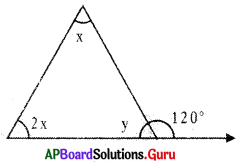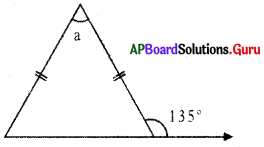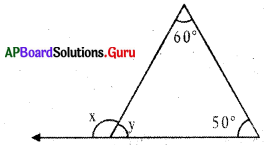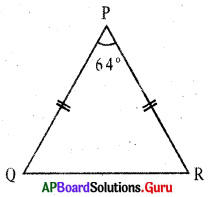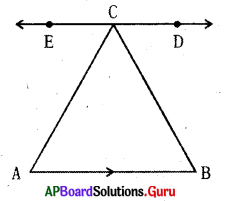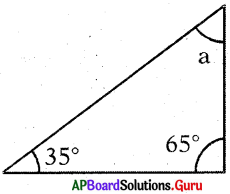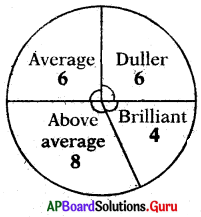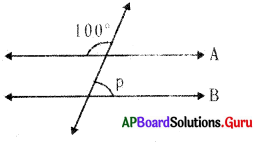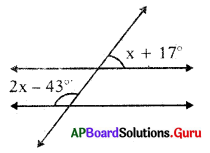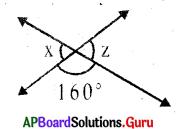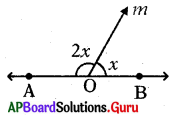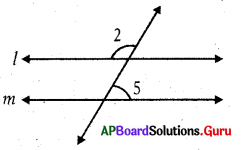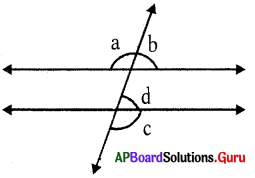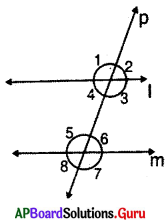Practice the AP 7th Class Science Bits with Answers 3rd Lesson జీవులలో పోషణ on a regular basis so that you can attempt exams with utmost confidence.
AP Board 7th Class Science Bits 3rd Lesson జీవులలో పోషణ
I. బహుళైచ్ఛిక ప్రశ్నలు
కింది వాటికి సరియైన జవాబులు గుర్తించండి.
1. జీవి పోషకాలను గ్రహించే విధానము
A) పోషణ
B) శోషణ
C) జీర్ణం
D) విసర్జన
జవాబు:
A) పోషణ
2. మొక్కలలోని పోషణ విధానము
A) స్వయంపోషణ
B) పరపోషణ
C) పరాన్నజీవనం
D) జాంతవ భక్షణ
జవాబు:
A) స్వయంపోషణ
![]()
3. కిరణజన్య సంయోగక్రియలో ఏర్పడే పదార్థము
A) పత్రహరితం
B) CO2
C) పిండిపదార్థం
D) అయోడిన్
జవాబు:
C) పిండిపదార్థం
4. పత్రరంధ్రాల పని
A) వాయుమార్పిడి
B) ఆహారం తయారీ
C) నీటి రవాణా
D) జీర్ణక్రియ
జవాబు:
A) వాయుమార్పిడి
5. పూతికాహార పోషణకు ఉదాహరణ.
A) పాములు
B) మొక్కలు
C) పుట్టగొడుగులు
D) జంతువులు
జవాబు:
C) పుట్టగొడుగులు
6. వృక్ష పరాన్న జీవి
A) కస్కుట
B) మర్రి
C) చింత
D) వేప
జవాబు:
A) కస్కుట
7. లైకెలో పోషణ విధానము
A) సహజీవనం
B) పరాన్నజీవనం
C) జాంతవ భక్షణం
D) పరాన్నజీవనం
జవాబు:
A) సహజీవనం
8. నులిపురుగుల నివారణకు ఇచ్చే మందు
A) పారాసెటమాల్
B) ఆల్బెండజోల్
C) సిటిజన్
D) జింకోవిట్
జవాబు:
B) ఆల్బెండజోల్
9. కస్కుటాలోని ప్రత్యేకమైన వేర్లను ఏమంటారు?
A) హాస్టోరియా
B) ఊతవేర్లు
C) తల్లివేర్లు
D) పీచువేర్లు
జవాబు:
A) హాస్టోరియా
10. లెగ్యుమినేసి మొక్కలలో పోషణ విధానం
A) పరాన్నజీవనం
B) సహజీవనం
C) పూతికాహారం
D) జాంతవ భక్షణ
జవాబు:
B) సహజీవనం
![]()
11. మిద్యాపాదాలు గల జీవి
A) ఆవు
B) అమీబా
C) పావురం
D) నెమలి
జవాబు:
B) అమీబా
12. మానవ ఆహారనాళం మొత్తం పొడవు
A) 7 మీ.
B) 8 మీ.
C) 9 మీ.
D) 10 మీ.
జవాబు:
C) 9 మీ.
13, రదనికలు ఏ జీవులలో స్పష్టంగా కనిపిస్తాయి?
A) శాఖాహారులు
B) మాంసాహారులు
C) ఉభయాహారులు
D) పక్షులు
జవాబు:
B) మాంసాహారులు
14. మానవ శరీరంలో అతి గట్టిదైన నిర్మాణం
A) దంతాలు
B) ఎముకలు
C) చేయి
D) గుండె
జవాబు:
A) దంతాలు
15. మానవునిలోని పోషణ విధానం ఏ రకానికి చెందుతుంది?
A) పరపోషణ
B) జాంతవ భక్షణ
C) పరాన్నజీవనం
D) పూతికాహారపోషణ
జవాబు:
B) జాంతవ భక్షణ
16. మానవునిలోని మొత్తం దంతాల సంఖ్య
A) 8
B) 16
C) 32
D) 64
జవాబు:
C) 32
17. ఏ పోషణ విధానం భూమిని శుభ్రపర్చుతుంది?
A) పూతికాహార పోషణ
B) జాంతవ భక్షణ
C) స్వయంపోషణ
D) పరపోషణ
జవాబు:
A) పూతికాహార పోషణ
![]()
18. చిన్నపిల్లలలో కనిపించని దంతాలు
A) కుంతకాలు
B) రదనికలు
C) చర్వణకాలు
D) అగ్రచర్వణకాలు
జవాబు:
D) అగ్రచర్వణకాలు
II. ఖాళీలను పూరించుట కింది ఖాళీలను పూరింపుము.
1. జీవులు ఆహారాన్ని తీసుకొనే విధానాన్ని ………….. అంటారు.
2. పోషణ రీత్యా మొక్కలు …………….
3. మొక్కలకు ఆకుపచ్చని రంగుని కల్గించే పదార్థం ………………….
4. మొక్కలు ఆహారం తయారు చేసుకొనే ప్రక్రియ ……………………
5. ……………… పోషణ పరిసరాలను శుభ్రంగా ఉంచటంలో తోడ్పడుతుంది.
6. ఆహారం కోసం, ఆశ్రయం కోసం వేరే జీవిపై ఆధారపడే జీవి ……………
7. పరాన్న జీవి …………….. పై ఆధారపడుతుంది.
8. అమీబాలో ఆహార సేకరణకు తోడ్పడునవి …………………………..
9. మానవుని జీర్ణవ్యవస్థ ఆహారనాళం మరియు ………………… కల్గి ఉంటుంది.
10. మానవుని నోటిలో దంతాలు …………… రకాలు.
11. చిన్న పిల్లలలో దంతాల సంఖ్య ……………..
12. మానవుని జీర్ణవ్యవస్థలో పొడవైన భాగం ……………
13. దంతాల పై పొర పాడైపోవడాన్ని ………….. అంటారు.
14. పాక్షికంగా జీర్ణమైన నెమరువేయు జంతువులలోని ఆహారాన్ని ……………….. అంటారు.
15. నెమరువేయు జంతువుల జీర్ణాశయంలోని రెండవ గది …………….
16. జీర్ణమైన ఆహారం రక్తంలో కలవడాన్ని …………. అంటారు.
17. వృక్ష పరాన్న జీవి ………………….
జవాబు:
- పోషణ
- స్వయంపోషకాలు
- పత్రహరితం
- కిరణజన్య సంయోగక్రియ
- పూతికాహార
- పరాన్నజీవి
- అతిథేయి
- మిద్యాపాదములు
- జీర్ణగ్రంథులు
- నాలుగు
- 20.
- చిన్నప్రేగు
- దంతక్షయం
- కడ
- జాలకం
- స్వాంగీకరణ
- కస్కుటా
III. జతపరుచుట
కింది వానిని జతపరుచుము.
1.
| Group – A | Group – B |
| ఎ) పత్రరంధ్రాలు | 1) వృక్ష పరాన్న జీవి |
| బి) ఎనామిల్ | 2) వాయుమార్పిడి |
| సి) లైకెన్లు | 3) జీర్ణాశయం |
| డి) ఎసిడిటి | 4) దంతం |
| ఇ) కస్కుటా | 5) సహజీవనం |
| 6) పత్రహరితం |
జవాబు:
| Group – A | Group – B |
| ఎ) పత్రరంధ్రాలు | 2) వాయుమార్పిడి |
| బి) ఎనామిల్ | 4) దంతం |
| సి) లైకెన్లు | 5) సహజీవనం |
| డి) ఎసిడిటి | 3) జీర్ణాశయం |
| ఇ) కస్కుటా | 1) వృక్ష పరాన్న జీవి |
2.
| Group – A | Group – B |
| ఎ) అమీబా | 1) ఎసిడిటి |
| బి) కుంతకాలు | 2) మిద్యాపాదాలు |
| సి) కాల్షియం | 3) స్వాంగీకరణ |
| డి) చిన్నప్రేగు | 4) దంతాలు |
| ఇ) జంక్ ఫుడ్ | 5) కొరకటం |
జవాబు:
| Group – A | Group – B |
| ఎ) అమీబా | 2) మిద్యాపాదాలు |
| బి) కుంతకాలు | 5) కొరకటం |
| సి) కాల్షియం | 4) దంతాలు |
| డి) చిన్నప్రేగు | 3) స్వాంగీకరణ |
| ఇ) జంక్ ఫుడ్ | 1) ఎసిడిటి |
